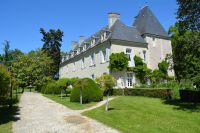Destilly, as it was then spelt, remained in the de Valori family from 1446 until it was briefly sold by Baudouin de Valori to Adam de Hodon in 1555.
But it was reclaimed only five years later by Baudoin’s younger brother, Philippe de Valori, under the lineage withdrawal right. Philippe was not very fortunate in his timing…
Two years later, in 1562, the mediaeval château was taken and burnt down by the Huguenots, led by count Gabriel de Montgomery who also took the royal fortress of Chinon.
Only some parts of buildings remained, including the 13th-15th C. chapel with a small building behind it… and escape tunnels linking Destilly to other châteaux in the area, of which the discreet entrance is still visible although the actual tunnels have collapsed.
Unluckily the tunnels were of little avail since over 400 soldiers and civilians perished in the attack, including two of the lord of Chinon’s own children.
Philippe de Valori, who fortunately for him was posted in Chinon at the time, had the château rebuilt between 1590 and 1610, largely as it stands today, although some enlargements and changes were subsequently made, particularly in the 19thcentury, such as the little tower on the east side which houses the servants’ staircase.
A monumental entrance gate leading to the previous main courtyard, now listed in the "Inventaire Supplémentaire des Monuments Historiques", was added in the 17th C.
Château de Détilly belonged to the de Valori family for many more generations until in 1793 it was seized by the French revolutionaries, who also severely damaged the gate when they hacked away the family coats of arms. Miraculously the chapel was spared, but was turned into a storeroom.
Many years later, in 1855, French courts granted the de Valori family the right to officially use its full name “de Valori-d’Estilly-Rustichelli” – a right it had applied for before the Revolution when it still owned the Château de Détilly, but not obtained before the events.





